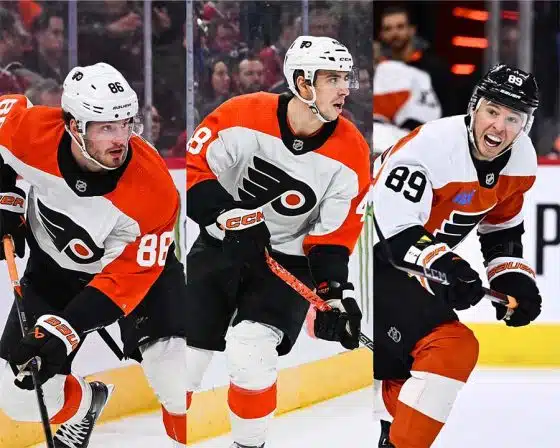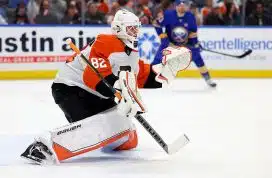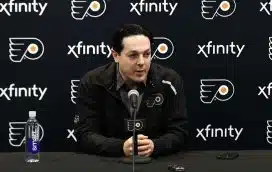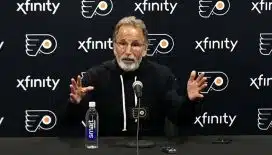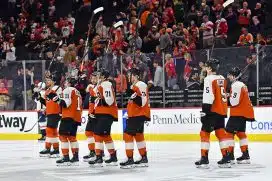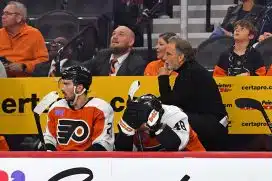(Kate Frese/Sports Talk Philly)
By Kevin Durso, Sports Talk Philly editor
When a season comes to an end and the playoffs aren’t part of the equation, the instant analysis shifts to what went wrong.
Positives and negatives are always a part of the game, but a season that ends like the Flyers did with the conclusion of the regular season on Sunday makes the negatives outweigh the positives.
Here are six areas where the Flyers season went wrong.
Road Woes
The Flyers home record was so good, it was better than several teams moving on to the playoffs. In total, the Flyers picked up 55 points in the standings on home ice. On the road, the Flyers finished the season with a 14-22-5 record and 33 points in the standings.
When at home, the Flyers have a different tone to their game. They play more energized, and that’s understandable. But for whatever reason, the Flyers just haven’t been able to get up for the games away from home. It’s been a problem that extends far beyond this season, but ultimately, when it came time to steal a game on the road, they couldn’t pull it off.
The teams making the playoffs this season have one thing the Flyers did not this season: consistency. That’s in games at home and on the road. The Flyers need to be better on the road next season to get back to the playoffs.
Special Teams
The power play at one time was tied for the NHL lead. That’s how good the Flyers were on the man-advantage. And then the switch flipped.
When the Flyers couldn’t buy a goal on the power play, they couldn’t seem to find a way to win either. Interestingly enough, that success seemed to stop right around January and February, shortly after the 10-game winning streak came to an end. Overall, the Flyers finished 14th in power play.
The penalty kill was a whole different issue. It remained inconsistent and while there were times when the Flyers were on their game even down a man, it only worked when they were active and pressured the puck. More times than not, the Flyers played passive on the penalty kill, and that only hurt them. They finished tied for 20th in penalty kill.
Inconsistent Scoring
If not for their recent stretch of success, albeit in meaningless games, the Flyers would not have had a single player reach 60 points. That’s not as much of a detriment as it seems, as a team like Columbus finished the season with more than 100 points in the standings, but only one/two players reaching the 60-point mark, including team leader Cam Atkinson who finished with 61 points.
The Flyers problem isn’t in the totals, it’s the consistency, particularly in the goal scoring area. With a goal on Saturday, Jake Voracek became the Flyers third player with 20 goals on the season. Wayne Simmonds had 31. Brayden Schenn had 25. The next highest players were Claude Giroux and Sean Couturier, tied with 14. The Flyers top five goal scorers combined for 103 goals.
Of those goals, 17 of Schenn’s 25 were on the power play. So were 16 of Simmonds’ 31 goals. Voracek and Giroux each had five on the power play. The Flyers top four goal scorers combined for 90 goals, but only 47 coming at even strength. That’s not good enough either.
Ultimately, the Flyers had to rely on their core players again, and when they couldn’t produce, the team didn’t have the depth to make up for it, at least not until the end of the season when the likes of Travis Konecny, Jordan Weal, Dale Weise and Valtteri Filppula started to add to the scoring.
The Flyers will be looking to make effective additions to the forward group, but may not need to do too much to get better overall — more on that below. There is talent that seems to be here already, it just needs to be utilized in the right places.
Lineup Confusion
So, about that talent. When the Flyers had Weal and Konecny in the lineup and on lines with core players, their play was noticeably elevated. Burying a player like Konecny on a line with Pierre-Edouard Bellemare and Chris VandeVelde may be a message-sender, but it’s not effective in the ultimate goal, putting the best lineup on the ice to win.
The Flyers big problem in this is a wealth of bottom-six forwards that never consistently picked up the slack. And while maybe the Flyers need to look at the core as much as the depth at the forward position, they need to better utilize the talent around the core to make them even more effective.
Dave Hakstol took a lot of heat for this, and rightfully so. His job beyond next season depends heavily on his ability to put winning lineups on the ice with consistency. Some dead weight will be shed this offseason and new weapons may be coming too. But that only helps the Flyers if it is all used correctly.
Defensive Zone Play
You can collectively lump goaltending and defensemen together in this case. The Flyers defensive zone play was inconsistent and sloppy throughout the season.
The Flyers don't have a full-on goalie problem on their hands. Steve Mason was streaky, but good for most of the year. Michal Neuvirth was inconsistent, but is the only goalie under contract for next season at this point. Anthony Stolarz looked good in a small sampling of games this season.
The Flyers can solve some of their defensive zone problems with players on expiring contracts. Nick Schultz and Michael Del Zotto will likely not be back. Radko Gudas, who was one of the few defensemen who improved this season, will be part of the group moving forward. Andrew MacDonald and Brandon Manning are sort of in limbo, given that the Flyers seem willing to bring some youth into the group by promoting Sam Morin and Robert Hagg to make their NHL debuts before the season ended.
Obviously, the pair of Ivan Provorov and Shayne Gostisbehere will be apart of this as well.
In some cases, experience will bring improvement. But mainly, the Flyers need to clean up possessions in their own zone. Zone exits were not good. Clearing attempts were prone to turnovers. It seemed that almost every time the Flyers committed a defensive zone turnover, it ended up in their net.
A Year Under Their Belts
Toward the end of the season, the Flyers gave you a real taste of the future.
First of all, a ton of praise should go to Provorov, not just for his mature demeanor on the ice, but his overall stamina. The 19-year-old rookie, who turned 20 during the season, played in all 82 games in his rookie season. That first season will go an incredibly long way in the future, if it hasn’t already, seeing as Provorov has progressed throughout the season.
Konecny missed some time with benchings and injury, but was also effective and will be better for the year under his belt too.
The first 50 games for Gostisbehere were rather forgettable too. He was clearly not the confident player he had been in his rookie season, but not playing so poorly as to deserve the punishment he was getting by sitting out games. To his credit, Ghost bounced back late in the season and with another year down, he should be even more ready to go in the third season of his career.
Add in players who got some form of a taste of NHL life this season like Weal, Stolarz, Morin, Hagg, Nick Cousins and Mike Vecchione and suddenly you have nine players with two years or less in the NHL potentially ready to join the roster, even if that experience is only one or two games. That experience will go a long way in the next year of their careers, whether that’s in the NHL or in one more season developing in the AHL.
That time is getting closer, and the more players the Flyers can provide that experience to now, the better. They did a solid job getting some rookies involved late in the season, indicating more is to come from these kids in the next year.

